Paxman 6VN Engine - No 23407
at Blenheim, Marlborough, New Zealand
| Number 23407 is the largest surviving Davey Paxman vertical heavy-fuel-oil engine still in working order. The order for the six cylinder Type VN was placed on 19th October 1929 by AGE (Agricultural & General Engineers Ltd) for the Marlborough Electric-Power Board (MEPB) of Blenheim, South Island, New Zealand and allocated order number 17377. The engine was despatched from the Colchester factory on 20th February 1930. As far as we know it was the only six cylinder VN ever built. Pictured to the right is the plate which shows the engine's number and refers to the spring injection system used in the VN. This system was devised by the Carter brothers who worked for Blackstone & Co. All four numbers in the lower half of the picture relate to Carter and Blackstone patents embodied in the design. |
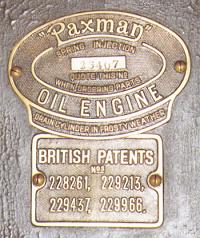 |
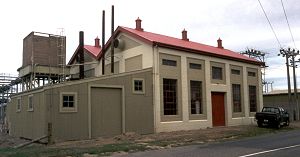 |
The engine was installed in a power generation facility which, in MEPB days, was usually referred to simply as the "Standby Plant" or sometimes the "Murphys Road Sub-station". The engine is still in its original building situated on the corner of Thomsons Ford Road and Old Renwick Road, in the north-western part of Blenheim. Adjacent to the building are the TransPower (formerly NZ Electricity Dept) Substation and Switchyard which supplies power to Marlborough from the National Grid. On the other side of Old Renwick Road, south of the Standby Station, is a 33,000/11,000 Volt Zone substation and the System Control Centre owned by Marlborough Lines Ltd, the successor to MEPB. Photo © Alex Walford |
The Tender for a Standby Plant
As at 1929 Marlborough's electricity supply was dependent on a hydro-electric installation at Waihopai. In February of that year there had been a water shortage and five weeks of very dry weather which caused grave anxiety about maintaining the electricity supply. MEPB's Chairman considered there was an even stronger possibility of disruption to the supply in mid-winter during a period of hard freezing. Because of the risks of interruption to the supply in the event of a water shortage or a breakdown in the hydro generation plant, the MEPB considered it imperative to procure a standby plant. One option was duplicating the hydro generator but this would not address the potential water shortage problems. The Power Board decided, therefore, to go for a diesel generator solution. (1)
By June 1929 the Board had drawn up a specification for a diesel plant and put it out for tender. John Bailey, formerly Network Project Manager at Marlborough Lines Ltd, sent me copies of the original specifications for the diesel engine, generator and switchgear. Whoever drew up the specifications had obviously done his homework and did a highly professional job with them. The requirements were very clearly and precisely set down. The specifications were tight both with regard to the quality of equipment to be supplied and the timescale for completing the contract. "The quality of materials throughout shall be of the best of its kind, and in accordance with the latest British Standards Specifications … and all parts shall be of substantial construction, modern design, with workmanship of the best grade … ." (2) Tenders had to be submitted by 12th August 1929 accompanied by a deposit of 2½% of the contract price.
James Niven & Co of Wellington declined to tender as their agency for diesel engines did not cover any of sufficiently high power. (3) The successful tender was submitted by the Wellington (NZ) branch of Cory Wright & Salmon. Still on file at Marlborough Lines Ltd is a letter from the MEPB to Cory Wright & Salmon, dated 27th September 1929, acknowledging receipt of their tender " … for supply, delivery, and erection of a 630HP Paxman engine, direct coupled to a 428kW English Electric Generator … " (the switchgear panel at the station indicates the power output as 430kW.) at a cost of £8,650-16s-3d. This was accepted at the MEPB's monthly meeting held on 16th October 1929 and confirmed in writing a few days later on 24th October. Apparently there was more trust in a verbal "gentleman's agreement" in 1929 than there might be now - the order was placed with Paxman before written acceptance of the tender was issued ! As previously mentioned, the engine was despatched from Colchester in February 1930. By this time Paxman had already supplied three 8 cylinder VN engines for large power generation installations in England, two at Ashford in Kent and one at Basingstoke in Hampshire.
Having a 15½" bore and 20" stroke, the VN was designed to run at 300 rpm. Old Paxman data sheets and catalogues quote the power output of the VN as 116.6 bhp per cylinder at 300 rpm. One would therefore expect the 6VN to be rated at 700 bhp but, as mentioned above, the accepted tender was for a 630 bhp engine. Perhaps the normal output was de-rated by 10% on account of the long continuous running which would be required in this application. The original tender called for a 600 hp engine.
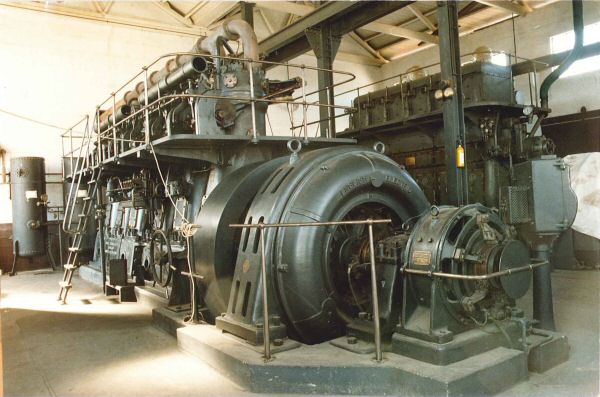
The Paxman 6VN, No 23407, at Blenheim with the Harland & Wolff behind.
Photograph courtesy of Marlborough Lines Ltd.
A History of the Stand-by Plant
On Saturday 15th November 2003 an open afternoon was held at Murphy's Road to mark the 80th Anniversary of the establishment of the MEPB. Robert Montgomery of Blenheim went along to the power house to see and hear the 6VN running. Robert's family have long associations with the engine as will be clear in what follows. After the visit, Robert emailed some history of the plant and the engine which is well worth sharing:
"The Marlborough Electric Power Board was established in 1923 and from 1927 generated electricity at its newly-constructed hydro-station on the Waihopai River, using two 500kW vertical-shaft turbines. The DP (i.e. the Davey Paxman 6VN) was purchased in 1930 by the Board to provide 430kW back-up power for the Waihopai hydro plant, which was subject to summer droughts and winter freeze-ups. She arrived just in time to avert major restrictions from yet another freeze-up in the headwaters.
The DP was brought across Cook Strait from Wellington as crated cargo aboard the scow "Echo". My uncle, Arthur Montgomery, a teenager at the time, watched as the crates were unloaded. When the largest was lowered onto a waiting lorry, there was great amusement when its front wheels came off the ground. He and his friends followed the precious cargo to the new power house at Springlands to see the DP assembled and later, test run.
At the time of its commissioning in July 1930 the DP was described as "a very giant among engines", being 10 foot high, 29 foot long and weighing 68 tons. The cost of the DP and the building was £12,000. Diesel cost £5-17s.-2d. per ton, and consumption was 1½ tons in sixteen hours. When installed, the DP could supply all the power needs of Blenheim, the principal town of the Marlborough region. At that time Blenheim had a population of just over 5,200.
Power consumption in the area increased to such an extent that a second generating set was purchased in 1937. Driven by a 1,300hp Harland & Wolff (a noisy beast!), the second set has an output of 900kW.
During an acute water shortage between January and May 1939 the standby plant was able to carry the bulk of the load; the Waihopai station being capable of adding only 100kW. By the outbreak of war the area supplied by the MEPB had increased to include the small townships of Havelock and Seddon, also much of the Awatere County. At its wartime peak in 1942, the region's population was swelled by some 12,000 men and women of the Armed Forces. While some of their camps and aerodromes had their own generating capacity the Board's facilities were put under great strain, and there was considerable "power rationing". This did not ease until December 1944 when power was supplied from the Cobb hydro scheme in the Nelson region.
The Marlborough region was not fully integrated into the South Island power distribution circuit until September 1958. Despite an increase in supply from Cobb in the mid-50s, post-war growth and increased electricity consumption meant that we faced ongoing "power rationing" and blackouts, particularly in winter. In those years the Davey Paxman and its companion, the Harland & Wolff, were in constant use and it was from that time I came to know and love the DP. My father, a cycle and motor-cycle dealer in Blenheim, was friendly with Mr Noel Webby who was in charge of the standby plant. He took a kindly interest in me and would often say to my father "bring the boy over", knowing that I was (and still am) enthralled by the sight and sound of those two "old ladies". Once he got my father to take me over quite early one morning and took me through the start-up procedure of the DP. I believe I walked out about 12" off the ground! Another time, during a period of "power rationing" he told me to pull down a lever on a control panel that used to stand in one corner of the power house - "You've just cut off the power to your house" he said, and added "To mine too" (he lived not far away, in an adjoining street). Noel Webby was quite a character and was associated with the standby plant for many years. For Noel Webby it was not work but a labour of love; he kept everything so clean you "could have confidently had your lunch on the catwalk".
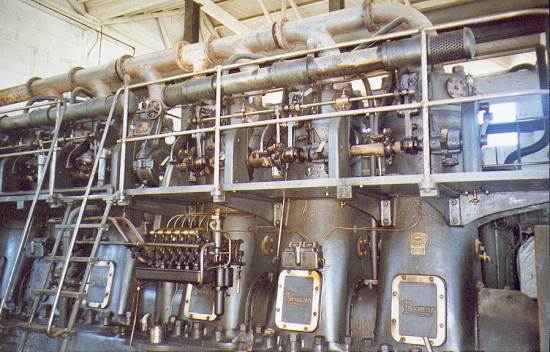
Just below the catwalk, to the right of the steps, is the low pressure fuel pump with the fuel lines leading off to the spring injectors. Immediately above the catwalk is the camshaft which operates the valvegear and spring injectors. Just below the top rail of the catwalk the air intake system is clearly visible, and above that the exhaust system leading off to the left of the picture.
The inclusion of Marlborough in the South Island distribution grid in 1958 put an end to power shortages - for the time being - and in September that year the two engines were put up for sale. The Board received not a single expression of interest, which was just as well for they were there when sorely needed soon afterward, and remained on standby duty until comparatively recent times. Apart from the obvious difficulty of moving them to another location, the lack of interest no doubt had much to do with the outdated technology, particularly that of the DP, which needs constant attention and is unsuitable for automatic running. An engine of today having a similar output would be much smaller, and a different machine altogether.
Once the board was connected to the National Grid, diesel generation was used generally only for "peak lopping". This entailed running for about 1½ hours, a dozen or so times a year, during the winter months to maintain the preset import load from the New Zealand Electricity Department. The engines were usually run from around 1630hrs to 1800hrs (NZST). The number of times this was required after 1983, when the Branch River Hydro power plant became operational, reduced even further to less than half a dozen times a year - still around the same time of day. In their final years of service the "old ladies" were tended by Ian De Boo.
The last logged, and therefore official, generation by the 6VN took place on 22nd June 1992 when it was brought 'on line' at 0800 hrs and taken off line at 1700 hrs (NZST). It ran in conjunction with the Harland & Wolff engine generating 1950kWhrs of energy and reaching a peak load of 300kW. Since then the engine has been run only in test or demonstration mode. The generation from the station was physically disconnected from Marlborough Lines reticulation system on 30th July 2003, mainly because of concerns about the safety, reliability and fault rating of the old switchgear. The generators are in good condition but to reconnect them with suitable gear would be both expensive and difficult. By 2003 the population of Blenheim was just over 26,000 and it is doubtful whether the two "old ladies" would then have been capable of supplying much more than 25% of the needs of the central business district of Blenheim!
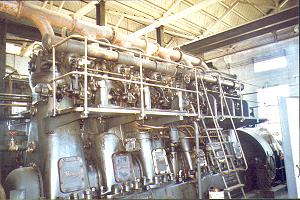 Day to day care of the two engines is now in the hands of the Marlborough Vintage Farm Machinery Society. The man currently responsible for the DP and H&W is John Johnson, who in 2013 took over from Ian Le Grice who had previous experience of Paxman engines during his time in the New Zealand Navy. From time to time there are 'open days' at the diesel station when members of the public can see the engines running. There was considerable surprise at the number of people who turned up for the November 2003 open afternoon as they happily queued to enter the generator house and emerged with smiles and ears ringing. I was impressed by the condition of both engines. They really sounded to be running sweetly".
Day to day care of the two engines is now in the hands of the Marlborough Vintage Farm Machinery Society. The man currently responsible for the DP and H&W is John Johnson, who in 2013 took over from Ian Le Grice who had previous experience of Paxman engines during his time in the New Zealand Navy. From time to time there are 'open days' at the diesel station when members of the public can see the engines running. There was considerable surprise at the number of people who turned up for the November 2003 open afternoon as they happily queued to enter the generator house and emerged with smiles and ears ringing. I was impressed by the condition of both engines. They really sounded to be running sweetly".
Among the archives of Marlborough Lines Ltd are cuttings from newspapers of 20th September 1958. One has the headline 'Diesel Standby Units On Their Way Out'. The other, from the Marlborough Express newspaper, has the headline 'Diesel Standby Units To Be Sold' and starts "The Marlborough Electric Power Board intends to dispose of its two diesel generating units. Tenders for their sale have been called, considered and rejected, and the Board is now awaiting developments from further enquiries. … They were used for regular supply purposes until May 1955 when the Cobb station increased its output. Since then they have been used periodically to reduce peak loading. They have run a combined total of 59,352 hours and have generated 25,240,620 units. The machines have been the "baby" of Mr N. E. Webby ever since they were installed. He started with the Board 28 years ago when the Paxman diesel was purchased and has maintained and operated them ever since." As Robert Montgomery commented above, it was fortunate the engines were not sold as they were subsequently required for peak lopping. It was also fortunate in that more than fifty five years after attempts were made to sell them, these engines are in preservation in the power house where they were originally installed and are still in good working order. If they had been sold in 1958 the likelihood is that they would not have survived.
Ownership of the Blenheim facility passed from the MEPB to Marlborough Electric Ltd in 1993 and then to Marlborough Lines Ltd, following restructuring of the electricity industry, in 1999.
As generation from the Murphys Road Diesel Station is no longer possible, Marlborough Lines Limited intends to preserve the building and its contents for historical puposes and eventually set it up as a museum. The site is very significant as it was constructed early in the life of MEPB, and the Paxman plant - along with the Waihopai Power Station and later the Harland & Wolff generator set - provided power to the Marlborough Province during its first 35 years of existence.
Marlborough Vintage Farm Machinery Society: The Society occupies an extensive area at the Brayshaw Historic Park where it has a considerable number of diesel engines restored to working condition, along with collections of tractors and other agricultural equipment. Enquiries can be sent to The Secretary at Marlborough Vintage Farm Machinery Society, PO Box 527, Blenheim.
Electrical Specifications and Performance
The Paxman 6VN drives a three-phase alternator which was built by English Electric at their Stafford Works in England. Although the control panel for the generating set carries a large plate which says "430 KW. SET", its actual capacity is greater. While John Bailey of Marlborough Lines was looking at some of the running logs for 1930/31 he noticed that there were many incidents of loads around 480kW to 570kW. This prompted him to examine the ratings plate on the alternator.
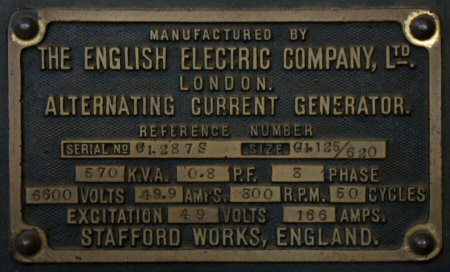
Ratings plate on the English Electric alternator.
The plate shows that the alternator is rated 570kVA, with a power factor of 0.8, generating 6,600 volts, 49.9 amps. It was designed to run at 300rpm to produce alternating current with a frequency of 50 cycles per second. Excitation: 49 volts, 166 amps.
The "Log Sheet of Murphy's Road Power Station" for 13th July 1930 records that the Total Units for the day were 350 and has a remark "First run on load". The Log Sheet for February 17th 1931 is much more detailed, with readings recorded at Noon and at 4pm, as follows:
Noon 6,650 Volts, 38 38 38 Amps, 430kW, Exciter: 40 Volts 148 Amps. PF 0.92.
4-00pm 6,675 Volts, 41 41 40 Amps, 440kW, Exciter: 42 Volts 151 Amps. PF 0.91.
The log goes on to record 'Total Units for day: 4390; Peak Load: 570kW; Machine In 8am Out 6pm.
Calculations suggest that at a peak loading of 570kW the Paxman engine would have been working very hard: at the limit or even over the limit of its maximum (overload) rating. (Those who are not conversant with electrical machinery ratings should be aware that there is an important difference between kW and kVA; they are not the same.)
Updates
No 23407 was run again at an open day in mid-July 2004. A good crowd of some eighty or so people came to re-live the early days of power generation in Marlborough. The engine looked and sounded as good as ever. Other open days have been held since. On Saturday 2nd August 2008 around 50 to 60 people attended despite recent storms in the area.
In autumn 2009 John Bailey, then Network Project Manager of Marlborough Lines, emailed to say: "We had an open day at the Station last Saturday, September 12th, when we had probably 100 or so people. The Paxman ran continuously for one and a half hours and heated up to levels that I hadn't seen/felt for many years. It brought back memories of the cold winter nights, when we used them for load peak-cutting. The smell of the warm oil and the heat radiating from the exhaust pipes, and that wonderful, sonorous beat of the air intake, … ." John sent an audio-visual clip with his email. Click on this link to see and hear the engine running during the open day (the clip is in WMV format and is about 4.12MB so a broadband connection is recommended).
As explained previously, the 6VN was first run on load on 13th July 1930. To mark the 80th anniversary of this event the engine was run again at an open day on Sunday 18th July 2010 when a good crowd of 60-75 people came to see it. John Bailey reported that the day went really well and that "the Paxman sounded every bit as good as usual".
Russell Gifford emailed in June 2015 to say that the 6VN was run on Saturday 30th May when 'she fired up beautifully'. This was followed by a second run the following day. Russell reports that they have a capable crew on hand in Blenheim.
In 2004 Paxman gifted its old VN series engine drawings to Marlborough Lines with the intention that they should be preserved for posterity. The drawings are available for inspection by prior arrangement with Marlborough Lines.
Acknowledgements:
Many thanks to the four New Zealanders from the Blenheim area who contributed by far the greater part of the material on this page: Robert Montgomery for his insight into the history of Marlborough Power Station and the 6VN; Bob Thoms and Ian Le Grice of the Marlborough Vintage Farm Machinery Society who assisted Robert with some details of the history; and John Bailey, formerly Network Project Manager, Marlborough Lines Ltd, for his invaluable help and support.
References
1. Marlborough Express, 20 June 1929. Report of meeting of the Marlborough Electric-Power Board on 19 June.
2. Marlborough Electric-Power Board - Specification for Diesel Engine & Generator 600 BHP, Part 1, para 2 'Quality of Materials & Workmanship.'
3. Letter from Jas J Niven & Co Ltd of Wellington, dated 1st July 1929, to W G G Cuddon Esq, Blenheim.
Bibliography: A History of the Marlborough Electric Power Board, "Marlborough Will Shine Tonight", S I Vercoe, 1973.
© Richard Carr and Robert Montgomery 2003, 2008.
Page updated: 20 JUN 2015
